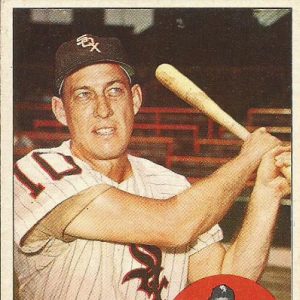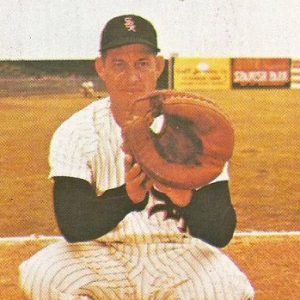calsfoundation@cals.org
John Sherman Lollar Jr. (1924–1977)
Sherman Lollar was a major league baseball player who was considered one of the best catchers in baseball during the 1950s. However, despite being a seven-time All-Star, his accomplishments, including winning the American League Gold Glove award the first three years it was given, were sometimes overshadowed by other players, such as New York Yankee Yogi Berra.
John Sherman Lollar Jr. was born on August 23, 1924, in Durham (Washington County) to John Lollar and Ruby Springfield Lollar. When he was three years old, the family moved to Fayetteville (Washington County), and his parents opened a grocery store. Lollar’s father died suddenly during surgery when Lollar was eight. His mother sold the grocery store and supported her young family by working in a nursing home for the Veterans Administration. As the oldest of four children, Lollar was forced to assume extra responsibilities. Despite his family duties, his love of baseball did not fade, although Fayetteville High School did not have a baseball team. Following his 1941 graduation, Lollar left home, taking a job with J. C. Penney in Pittsburg, Kansas.
While working, Lollar also attended Pittsburg State Teachers College (now Pittsburg State University). He still found time for baseball, playing in the Ban Johnson League for a team affiliated with the local chamber of commerce. Two years later, after the league folded, Lollar, who by then was working as a brakeman in a local mine, both played for and managed the Baxter Springs (Kansas) Miners, a local semi-pro team. In 1943, Lollar was signed by the Baltimore Orioles of the International League. He got off to a rough start, hitting only .118 in twelve games, but the following season he raised his average to .250 while hitting fifteen home runs and driving in seventy-two runs. In 1945, Lollar came into his own, winning the International League’s Most Valuable Player Award as he hit a league-leading .364 with thirty-four home runs and 111 runs batted in. His performance led the Cleveland Indians to purchase Lollar’s contract for $10,000.
He made his major league debut with the Indians on April 20, 1946, playing behind veteran catchers Frankie Hayes and Jim Hegan. His playing time was limited, however, so he asked to go back to Baltimore, where he could play regularly. The request was granted, but Lollar struggled, hitting only .234 with twenty home runs in sixty-seven games.
Given their wealth of catchers, the Indians traded Lollar in December 1946 to the New York Yankees, but they, too, had a backlog at catcher, and he was traded to the St. Louis Browns after the 1948 season. However, before the trade, Lollar won a World Series ring, when despite playing in only eleven games for the Yankees during the 1947 season, he appeared in two games in the series, getting three hits in four at-bats for the World Series champions.
In three seasons with the Browns, Lollar established himself as a strong major league catcher, and he was named an All-Star for the first time in 1950 when he hit .280 with thirteen home runs and sixty-five runs batted in. But in November, with the White Sox looking for quality catching, the Browns sent Lollar to the Sox as part of an eight-man trade.
Joining the White Sox proved to be the break Lollar had been waiting for. From 1952 to his release after the 1963 season, Lollar crafted a career that included selection to eight All-Star games, as well as the first three American League Catcher Gold Glove Awards, honors he earned in 1957, 1958, and 1959. Too, from 1954 to 1960, he consistently earned a spot on Most Valuable Player Award ballots. He also made another World Series appearance as the 1959 White Sox won the American League pennant by five games over the runner-up Indians, before losing the series to the Los Angeles Dodgers in six games.
His performance declined beginning with the 1960 season, and the White Sox released him at the end of the 1963 season, in which he had appeared in only thirty-five games.
After his playing career ended, Lollar aspired to manage in the minor leagues, and after serving as a coach with the Baltimore Orioles from 1964 through 1967 and the Oakland Athletics in 1968, he managed the Athletics’ Iowa Oaks club of the American Association from 1970 through 1972 and their Pacific Coast League entry, the Tucson Toros, in 1973 and 1974. His tenure with the Toros ended after a reported dispute with the Athletics’ mercurial owner, Charley Finley.
In the final years of his life, Lollar ran a bowling alley in Springfield, Missouri, and also refereed high school basketball games. Following a long battle with cancer, he died on September 24, 1977. Lollar was survived by his wife, Connie, whom he had met when he was playing in Baltimore, and a son, Sherman III. He is buried in Rivermonte Memorial Gardens in Springfield. He was posthumously inducted into the Fayetteville Schools Hall of Honor in 2015.
For additional information:
McMurray, John. “Sherm Lollar.” SABR BioProject. https://sabr.org/bioproj/person/565b7d20 (accessed December 31, 2020).
“Sherm Lollar.” Baseball Reference. https://www.baseball-reference.com/players/l/lollash01.shtml (accessed December 31, 2020).
“Sherman Lollar, an Ex‐Catcher for White Sox, Is Dead at 53.” New York Times, September 26, 1977, p. 40.
William H. Pruden III
Ravenscroft School
 Recreation and Sports
Recreation and Sports World War II
World War II Sherm Lollar
Sherm Lollar  Sherm Lollar
Sherm Lollar 



Comments
No comments on this entry yet.